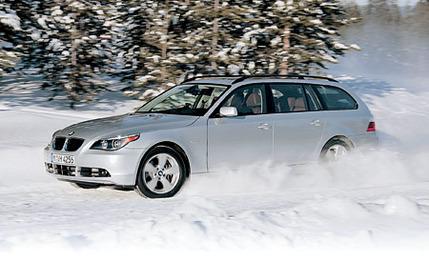
 First Drive Review
First Drive Review
All-wheel drive is creeping into more and more sports sedans as automakers try to soothe their sedan customers with the promise of stress-free all-weather capability. No need to buy an SUV if there is a relatively fuel-efficient, fun-to-drive, four-door alternative on the showroom floor. Premium brands, beginning with Audi and followed by just about everyone else with a coffee bar at the dealership, offer at least one all-wheel-drive sedan-the more the better. So after dipping a 3-series-sized toe into the waters, BMW has determined that the pool is warm and large enough for the addition of all-wheel-drive 5-series models.
The three 5s taking the plunge into AWD are the 525xi and 530xi sedans and the new 530xi wagon. All-wheel drive on the sedans will add about $2000 when it goes on sale this summer, and the wagon will come only with all-wheel drive for a starting price of about $50,000. The wagon's roofline extension adds 3.6 cubic feet to the cargo area for a total of 17.6 cubic feet; that's more room than you'll find in an X5, but less than the X3's 30 cubic feet. Fold the rear seats, and you'll have 58.3 cubic feet.
Both six-cylinder sedans will continue to come standard with rear-wheel drive for purists who believe the front wheels are challenged enough by steering.
The all-wheel-drive system assigned to increase accelerative traction on the 5-series is the familiar xDrive found on BMW's X3 and X5 sport-utes. Slight alterations were made to accommodate the 5-series' comparatively cramped underbelly. Most notably, the transfer case that diverts power to the front wheels had to be reduced in size to avoid altering the floor with an ugly wart. The 5's more compact transfer case uses three gears instead of the less space-efficient two-gear and chain system that fits under the SUVs. Operation of the system is essentially the same as that of the SUVs. A computer-controlled clutch locks and unlocks, sending as much as 50 percent of the torque to the front wheels, depending on what the stability-control system determines to be the need. When no slip is detected, power goes solely to the rear wheels. The transition from rear-wheel drive to all-wheel drive is quick and seamless. The only detectable difference is the ability to accelerate hard when the roads are as slippery as a dashboard with a fresh coat of Armor All.
So, rear-drive old-schoolers, you're probably wondering how xDrive affects the 5's heralded handling. Is it possible to hang out the rear end under power? Since the engine is still directly connected to the rear wheels (there is always at least 50 percent of the power going to the rears), completely switching off the stability control will allow for power oversteer if you're so inclined. Keep the stability control engaged, and even the most ham-fisted driver will have trouble losing control of the vehicle. If you're in the mood for sliding the car around but still want to be saved if things get too hairy, the stability-control system has the dynamic traction control (DTC) setting. Compared with the fully deployed stability control, DTC doesn't dial back the throttle and allows the driver to slide the vehicle more before the brakes intervene to bring the car back into line.
Making power slides even easier this year is BMW's new 255-hp, 3.0-liter inline-six. This lightweight engine has 30 more horsepower than the previous 3.0-liter in the 5-series and will be available in both rear-drive and all-wheel-drive versions of the 530i. Incidentally, the 525 will get a simplified, lower-power (215 horses) version of the 3.0-liter engine. The 255-hp engine feels stronger than the engine it replaces and deals easily with the extra weight and friction of the all-wheel-drive system as well as the extra weight of the wagon. The engine seems to be as happy when flogged to the 7000-rpm redline as when it's idling. AWD wagon and sedan buyers get two ways to exploit the engine's masochistic tendencies: a six-speed manual or automatic. The all-wheel-drive 5s don't get the sequential manual that rear-drive-sedan buyers can opt for, and they won't miss it much.
The addition of all-wheel drive increases the appeal of BMW's mid-size six-cylinder line to weather-suffering buyers, and the new 3.0-liter makes for a more enthusiastic 5-series. It's a shame the styling adjustments that sharpened and toned the new 7-series exterior didn't make it onto the 5. But at least the wagon's rear-end styling is an improvement over the sedan's. We still aren't in love with iDrive and the 5-series interior, but when the weather turns bad, all-wheel drive will make it a bit less likely that you'll be trapped in there for long.